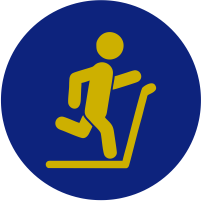Tennis Injuries & Prevention
Planning for Your Environment

Try to avoid playing on hard surface courts with no “give,” such as cement, asphalt, or synthetic courts. To prevent lower back injuries when playing tennis on hard surface courts, wear heel inserts to absorb the shock.
Preparation
Always take time to warm up and stretch. Research studies have shown that cold muscles are more prone to injury. Warm up with jumping jacks, stationary cycling or running or walking in place for 3 to 5 minutes. Then slowly and gently stretch, holding each stretch for 30 seconds.
Be knowledgeable about first aid and be able to administer it for minor injuries, such as facial cuts, bruises, or minor tendonitis, strains, or sprains.
Be prepared for emergency situations and have a plan to reach medical personnel to treat injuries such as concussions, dislocations, elbow contusions, wrist or finger sprains, and fractures.
Dress Appropriately
Wear tennis shoes with good support to prevent ankle injuries. For added support, wear two pairs of socks or specially padded tennis socks.
To prevent blisters on your hands, dry your racket handle frequently.
Focus on Technique
When serving or hitting an overhead, do not arch your back unnecessarily. Instead, bend your knees and raise your heels, so your upper body weight is evenly balanced.
Avoid landing on the ball of your foot, which could result in an
Achilles tendon injury.
Plantar fasciitis can occur if your foot is overused. Rest is the best remedy; but wearing a tennis shoe with medial arch support or a heel cup can sometimes alleviate the pain.
Our team is here for you
We offer the best, least invasive and least aggressive options to relieve your pain and symptoms so you can get back to the life you love. Atlantic Orthopaedic Specialists Sports Medicine Care Center has convenient locations in Virginia Beach, Norfolk and Chesapeake.



